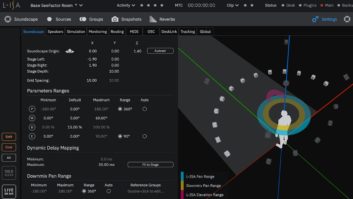
Apple Music has unveiled a new Spatial Audio edition of the Beatles compilation, 1, remixed for Spatial Audio with Dolby Atmos by Giles Martin. To mark the occasion, Martin sat down Monday for an industry press discussion of the process behind the music. Here, he discusses his philosophy for mixing immersive music, the hardest Beatles tracks to remix for the format, and getting the stamp of approval from Paul McCartney himself. Don’t miss out on Part 1!
Given that the albums are considered classics, there are those critics and fans who reasonably wonder if remixing the Beatles’ work for an immersive environment risks tarnishing the band’s legacy. If the songs were already deemed masterpieces when they were released in mono and stereo more than 50 years ago, do Spatial Audio mixes take them too far away from their roots and the way they were meant to be heard?
While Martin clearly had his own thoughts on the matter (“I think Sgt. Pepper’s is the first Dolby Atmos record,” he half-joked), he took pains to point out that the decision to remix the tracks—and, ultimately, to release them—came down from the Beatles themselves: “Paul and Ringo are always going, ‘How can we push technology? How can we change the way [you experience it]?’ So it made sense to me to do Sgt. Pepper’s—one of most famous albums of all-time—in new technology, because that’s what The Beatles want. Paul says, ‘I don’t want to be stuck in a museum. I don’t want to be under a glass case. I want people to discover things. I want people to listen to stuff and to explore. I want people to have an opinion about things….’ The Beatles don’t want to be on top of some mountain going, ‘Don’t touch it.’ Some people said to me, ‘Why would you go and do this?’ I go, ‘Because they asked me to!’ I don’t go do this work because I’m bored and there’s a cupboard of Beatles records I need to go look at.”
While the raw materials were the work of his father, to Martin’s credit, he’s been working with them in various surround formats for the better part of 20 years now, and brought that experience to the table for the new Spatial Audio remixes. “I’ve been working in surround for a long time, you know. I did the Love show in Vegas [in 2006], which has 7,000 speakers in a room, and we did a surround sound record [in the short-lived DVD-Audio format] which was very successful—but then you couldn’t hear it anywhere. People don’t have surround sound unless they’re very niche. It took a company like Apple to work out how to make it a consumer experience on a grand scale, you know? It’s all very well that I could put people in a room that I can build and go ‘This is gonna be an amazing experience,’ but how do you then have it so it’s easily accessible for people?”
While the immersive formats have changed since then, Martin’s philosophy for what an immersive mix should accomplish has stayed the same, using immersive’s inherent immediacy to create an emotional experience. “You’re going to have more intimacy and then you’re going to notice, hear it, really listen to it and it’s going to touch you—and that’s what music is about,” he said. “I don’t want people to listen to these mixes and go, ‘This is a mix.’ I want people to listen to the song and go, ‘How does it make me feel?’ That’s the key.”
The Ultimate Remix: The Beatles 50th Anniversary Editions
Creating an emotional response in the listener was always the Beatles’ forte, whether on their complicated, layered later work or their comparatively sparse but equally exciting early hits. Martin found during the remix project, however, that working on an earlier track that had less instrumentation didn’t necessarily make for a quicker mix.
“It does really vary,” he admitted. “It can take half a day or three days, or ages if you get it wrong; it’s as simple as that. The reason was, for a lot of the stuff like the early, early material, we’ll go back into Studio Two where the band recorded and we’ll find a way of re-recording the room so [that] you have ‘Studio Two’ around you when you listen to it. That takes a while. That’s the process—we’re mixing not just the original tracks, but actually capturing ambiance of the room that they’re in [in order] to make it more real…. And sometimes, some tracks just take ages because you just think ‘This doesn’t feel right.’
“There’s always a few troublemakers, in all honesty. ‘A Hard Day’s Night’ was tough because of the way it was done. I’m going to get this wrong, [but] it’s got John’s vocal, acoustic guitar and congas on one track; guitar, drums and bass on another track; John and Paul; another guitar, I think, on another track. And it’s that balance [you need to preserve]. If you start splitting [it apart into] Spatial Audio as opposed to mono, the levels change because of compression. There’s a lot of technical stuff that goes on, and to get the same feel was tough with that.”
On the other hand, other tracks seemed as if they were tailor made to be reinterpreted into an immersive format, he said. “‘A Day in the Life’ sounds really good in Spatial Audio. That was really tough, just because it’s such an important song and it’s…a four track….so it’s an acoustic guitar, piano, shakers and maracas and conga [on one track]; there’s bass and drums [on a track]; there’s a vocal track; and then there’s…all the strings on one track—and you’re thinking, ‘That’s one of the biggest records ever—and it’s only got four things!’
Finding the right approach to make the most of those elements required strategy: “You have to think, OK—if people listen to that Spatial, they’ll hear the piano and acoustic guitar on this side of the shaker, and they’ll hear the bass and drums on the other side, because you can only put them on [together], and then the vocals in the middle, and the strings go around you. And it’s getting that balance—getting that feel right.”
Of course, what feels right to one person might leave another cold, and regardless of the time and effort put into the Spatial Audio mixes, none of them were going to be released into the wild without the full stamp of approval from the Beatles themselves. “It’s like a family and there’s pressure involved, but it’s not as though we have marketing meetings and we sit as a board,” Martin explained. “It’s Paul and Ringo, and then there’s Olivia and Dhani, and then there’s Sean and Yoko. We communicate, we send stuff around, we go ‘Listen to this’ and they’ll make comments. They love the technology; they love the idea of people listening in different ways. I know this from my dad as well: They never thought that in 60 years’ time that people would be listening to this stuff.”
10 Things We Learned From Glyn Johns’ “Sound Man”
Sending a mix to someone to check elsewhere is one thing, but listening back to it under the in-person scrutiny of a legend who created it is something else entirely. “We have an Atmos room here at Abbey Road, and Paul came to listen to Sgt. Pepper. We sat and we listened to it. He wandered around the room—it’s a big room—and said, ‘We were a really good band.’ I was like, ‘Yeah, you were.’ He goes, ‘You know, we were really lucky to have your dad.’ And I said, ‘Well, I think, you know, he was lucky.’ And he goes, ‘And we’re really lucky to have you,’ and I went, ‘Oh God, no, come on.’ You know? ‘I think about how lucky I am.’ He goes, ‘We’re all lucky then.’
“So yeah, there’s so much love and passion and care attached, that goes into [these mixes]. And if I can make them happy, and then other people listen to it and they can hear the passion that goes into it, then that’s that a job worthy of being done.”







